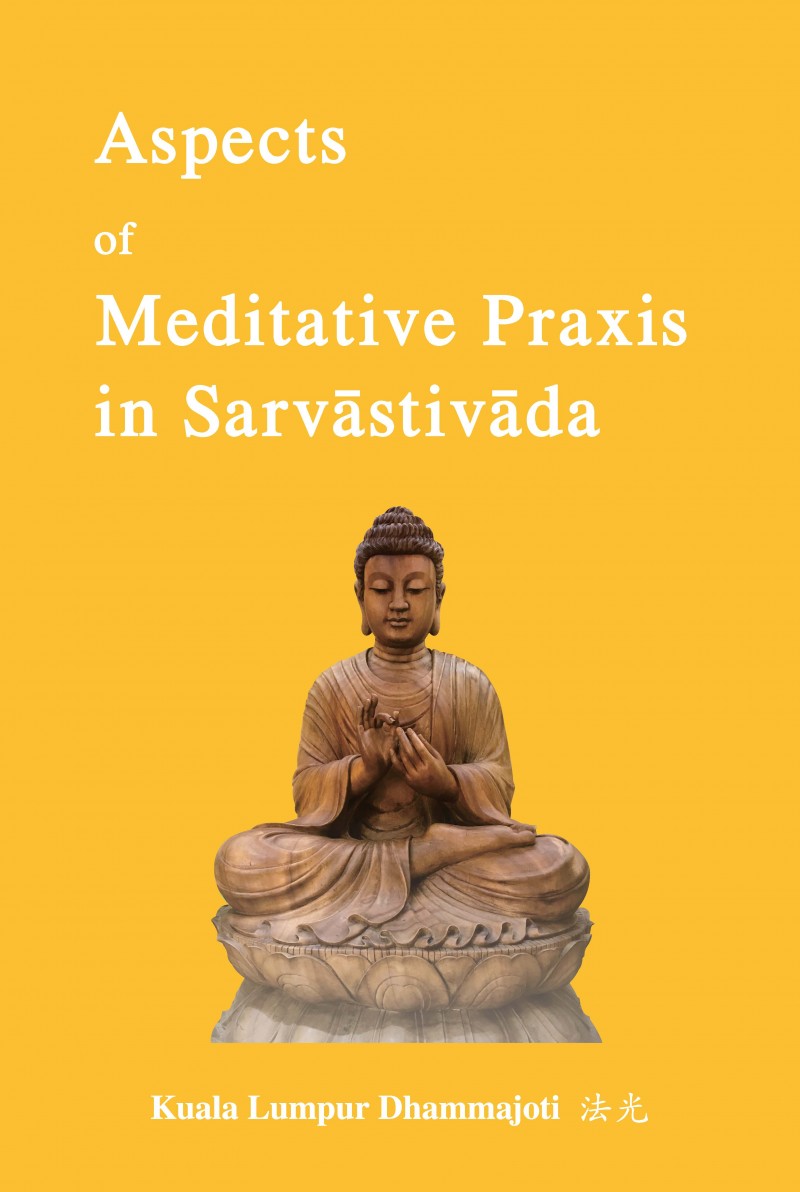Aspects of Meditative Praxis in Sarvāstivāda

Aspects of Meditative Praxis in Sarvāstivāda
K L Dhammajoti
The Buddha-Dharma Centre of Hong Kong, Hong Kong, 2021
ISBN 978-988-16820-4-8
Contents
1. The Sixteen-mode Mindfulness of Breathing 7
1.0. The unique position of the mindfulness of breathing in the Buddhist tradition 7
1.1. The 16 modes of ānāpāna-smṛti 9
1.2. The Theravāda Tradition 21
1.3. The *Śāriputrābhidharma 23
1.4. The Sarvāstivāda lineage 25
1.5. The Sautrāntika-Dārṣṭāntika tradition 33
1.6. The ŚrBh 36
1.7. Summary 38
2. The Doctrine of the Six-stage Mindfulness of Breathing 47
2.1. Introduction 47
2.2. Enumeration of the stages in the various commentaries 47
2.3. The four-stage variant 49
2.4. Explanations of the six stages in the MVŚ 50
2.5. Explanations in the Abhidharmakośa-bhāṣya and the *Nyāyānusāra 52
2.6. Description in the *Dharmatrāta-dhyāna-sūtra (達摩多羅襌經) 54
2.7. The early Yogācāra tradition 56
2.8. Conclusion 57
3. The Apramāṇa Meditation in the Sarvāstivāda — With Special 61 Reference to Maitrī-bhāvanā
3.1. Introduction 61
3.2. Definition of terminologies 62
3.3. The four immeasurables as positive qualities (guṇa) accompanying spiritual attainment 64
3.4. The immeasurable meditations and abandonment of defilements 65
3.5. The immeasurable meditation as a praxis conducing to moral transformation and liberative insight 68
3.6. The method of practice in the Sarvāstivāda Abhidharma texts 71
3.7. Conclusion 78
4. Adhimukti, meditative experience and Vijñaptimātratā 83
4.1. Adhimukti/adhimokṣa in the Pāli sutta-s and Chinese āgama texts 83
4.2. Adhimokṣa in the Abhidhamma and Abhidharma 85
4.3. Adhimokṣa and other related terms: vimokṣa, śraddhā, kṣānti, ruci, chanda, adhyāśaya, etc. 96
4.4. Adhimukti as a determinant for rebirth in Early Buddhism and the Basic Section of the Yogācārabhūmi 99
4.5. Adhimokṣa and kṣānti as understanding or preliminary insight that leads to ultimate pure insight 101
4.6. Adhimukti in buddha visualization 109
4.7. Further employment of the concept of adhimukti in the later Yogācāra texts 112
4.8. Conclusion 115
5. The aśubhā meditation in the Sarvāstivāda 123
5.1. Abhidharma and meditative praxis 123
5.2. The various contexts of the application of the aśubhā 124
5.3. The three levels of mastery 147
5.4. From the impure to the pure 150
5.5. Is the aśubhā of the nature of an erroneous illusion? 157
5.6. Concluding remarks 162
6. Meditative Experiences of Impurity and Purity — Further Reflection on the aśubhā Meditation and the śubha-vimokṣa 171
6.1. Preliminary remarks 171
6.2. Further Canonical Evidence for the Consistent Recommendation on the aśubhā 173
6.3. The Question of Authenticity of the Suicide Story 175
6.4. The Psycho-Spiritual Significance of the aśubha-to-śubha Transition and the Eight-Vimokṣa Scheme of Praxis 180
6.5. The Canonical Mention of the Seven-Element Doctrine and the Vimokṣa Doctrine 189
6.6. The Abhibhvāyatana-scheme and the Kṛtsnāyatana-scheme, and Their Correlation with the Vimokṣa-scheme 193
6.7. The Significance of the aśubha-to-śubha Transition in Terms of the Meditative Doctrines 200
6.8. From the aśubhā to śubha-bhāvanā, to Mahāyānistic Buddha-Visualization 206
6.9. Concluding summary 217
7. The nirvedhabhāgīyas as preparation for the realization of Truth — The Abhidharma and early Yogācāra perspectives 231
7.1. Introduction 231
7.2. Early development of the nirvedha-bhāgīya doctrine in the Abhidharma 232
7.3. Emphasis of faith and resolute receptivity in Early Buddhism as preconditions for perfect realization 241
7.4. Nirvedha-bhāgīya, kṣānti and adhimukti in the Mahāyāna development 244
7.5. Summary 248
8. Prajñā-vimukta, ubhayatobhāga-vimukta and vimokṣāvaraṇa — The Sarvāstivāda perspective 253
8.0. Introduction 253
8.1. Explanations of paññāvimutta and ubhatobhāga-vimutta in the Sthaviravāda suttas/sūtras 254
8.2. The Mahāsāṃghika tradition 255
8.3. The Sarvāstivāda Abhidharma tradition 256
8.4. Meditation‐hindrance, liberation‐hindrance, non‐defiled nescience, and “liberated in both parts” 264
8.5. Conclusion 272
